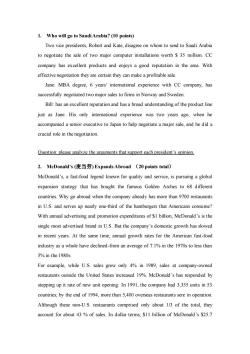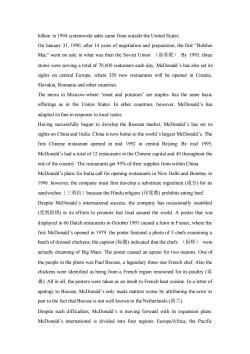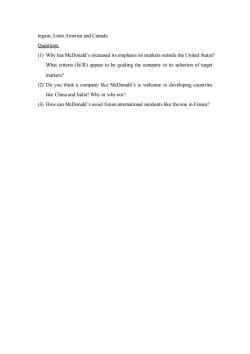《市场营销学》课程教学案例(双语)Who will go to Saudi Arabia

1.Who will go to SaudiArabia?(10 points) Two vice presidents,Robert and Kate,disagree on whom to send to Saudi Arabia to negotiate the sale of two major computer installations worth $35 million.CC company has excellent products and enjoys a good reputation in the area.With effective negotiation they are certain they can make a profitable sale. Jane:MBA degree,6 years'interational experience with CC company,has successfully negotiated two major sales to firms in Norway and Sweden Bill:has an excellent reputation and has a broad understanding of the product line just as Jane.His only international experience was two years ago,when he accompanied a senior executive to Japan to help negotiate a major sale.and he did a crucial role in the negotiation Question:please analyze the arguments that support each president's opinion 2.McDonald's(凌当劳)ExpandsAbroad(20 points total) MeDonald's,a fast-food legend known for quality and service,is pursuing a global expansion strategy that has bought the famous Golden Arches to 68 different countries.Why go abroad when the company already has more than 9700 restaurants in U.S.and serves up nearly one-third of the hamburgers that Americans consume? With annual advertising and promotion expenditures of $1 billion,MeDonald's is the single most advertised brand in U.S.But the company's domestic growth has slowed in recent years.At the same time,annual growth rates for the American fast-food industry as a whole have declined-from an average of 7.1%in the 1970s to less than 5%in the 1980s. For example.while U.S.sales grew only 4%in 1989,sales at company-owned restaurants outside the United States increased 19%.McDonald's has responded by stepping up it rate of new unit opening.In 1991,the company had 3,355 units in 53 countries,by the end of 1994,more than 5,400 overseas restaurants sere in operation. Although these non-U.S.restaurants comprised only about 1/3 of the total,they account for about 43%of sales.In dollar terms,$11 billion of MeDonald's $25.7
1. Who will go to Saudi Arabia? (10 points) Two vice presidents, Robert and Kate, disagree on whom to send to Saudi Arabia to negotiate the sale of two major computer installations worth $ 35 million. CC company has excellent products and enjoys a good reputation in the area. With effective negotiation they are certain they can make a profitable sale. Jane: MBA degree, 6 years’ international experience with CC company, has successfully negotiated two major sales to firms in Norway and Sweden. Bill: has an excellent reputation and has a broad understanding of the product line just as Jane. His only international experience was two years ago, when he accompanied a senior executive to Japan to help negotiate a major sale, and he did a crucial role in the negotiation. Question: please analyze the arguments that support each president’s opinion. 2. McDonald’s (麦当劳) Expands Abroad (20 points total) McDonald’s, a fast-food legend known for quality and service, is pursuing a global expansion strategy that has bought the famous Golden Arches to 68 different countries. Why go abroad when the company already has more than 9700 restaurants in U.S. and serves up nearly one-third of the hamburgers that Americans consume? With annual advertising and promotion expenditures of $1 billion, McDonald’s is the single most advertised brand in U.S. But the company’s domestic growth has slowed in recent years. At the same time, annual growth rates for the American fast-food industry as a whole have declined-from an average of 7.1% in the 1970s to less than 5% in the 1980s. For example, while U.S. sales grew only 4% in 1989, sales at company-owned restaurants outside the United States increased 19%. McDonald’s has responded by stepping up it rate of new unit opening. In 1991, the company had 3,355 units in 53 countries; by the end of 1994, more than 5,400 overseas restaurants sere in operation. Although these non-U.S. restaurants comprised only about 1/3 of the total, they account for about 43 % of sales. In dollar terms, $11 billion of McDonald’s $25.7

billion in 1994 systemwide sales came from outside the United States. On January 31,1990.after 14 years of negotiation and preparation,the first"Bolshoi Mac”went on sale in what was then the Soviet Union(前苏联).Byl995,three stores were serving a total of 70,000 customers each day.MeDonald's has also set its sights on central Europe,where 350 new restaurants will be opened in Croatia, Slovakia,Romania and other countries The menu in Moscow-where "meat and potatoes"are staples-has the same basic offerings as in the Unites States.In other countries.however,McDonald's has adapted its fare in response to local tastes. Having successfully begun to develop the Russian market,MeDonald's has set its sights on China and India.China is now home to the world's largest MeDonald's.The first Chinese restaurant opened in mid 1992 in central Beijing.By mid 1995. MeDonald's had a total of 12 restaurants in the Chinese capital and 40 throughout the rest of the country.The restaurants get%oftheir supplies from within China MeDonald's plans for India call for opening restaurants in New Delhi and Bombay in 1996.however,the company must first develop a substitute ingredient()for its sandwiches(三明治)because the Hindu religion(印度教)prohibits eating beef. Despite MeDonald's international success,the company has occasionally stumbled (受到阻碍)in its efforts to promote fast food around the world.A poster that was displayed in66 Dutch restaurants in October 1991 caused a furor in France,where the first MeDonald's opened in 1979.the poster featured a photo of 5 chefs examining a batch ofdressed chickens,the caption(标题)indicated that the chefs(厨师)were actually dreaming of Big Macs.The poster caused an uproar for two reasons.One of the people in the photo was Paul Bocuse.a legendary three-star French chef.Also the chickens were identified as being from a French region renowned for its poultry( All in all,the posters were taken as an insult to French haut cuisine.In a letter of apology to Bocuse,MeDonald's only made matters worse by attributing the error in part to the fact that Bocuse is not well known in the Netherlands(). Despite such difficulties,MeDonald's is moving forward with its expansion plans. MeDonald's interational is divided into four regions:Europe/Africa,the Pacific
billion in 1994 systemwide sales came from outside the United States. On January 31, 1990, after 14 years of negotiation and preparation, the first “Bolshoi Mac” went on sale in what was then the Soviet Union (前苏联). By 1995, three stores were serving a total of 70,000 customers each day. McDonald’s has also set its sights on central Europe, where 350 new restaurants will be opened in Croatia, Slovakia, Romania and other countries. The menu in Moscow-where “meat and potatoes” are staples- has the same basic offerings as in the Unites States. In other countries, however, McDonald’s has adapted its fare in response to local tastes. Having successfully begun to develop the Russian market, McDonald’s has set its sights on China and India. China is now home to the world’s largest McDonald’s. The first Chinese restaurant opened in mid 1992 in central Beijing. By mid 1995, McDonald’s had a total of 12 restaurants in the Chinese capital and 40 throughout the rest of the country. The restaurants get 95% of their supplies from within China. McDonald’s plans for India call for opening restaurants in New Delhi and Bombay in 1996. however, the company must first develop a substitute ingredient (成分) for its sandwiches(三明治)because the Hindu religion (印度教) prohibits eating beef. Despite McDonald’s international success, the company has occasionally stumbled (受到阻碍) in its efforts to promote fast food around the world. A poster that was displayed in 66 Dutch restaurants in October 1991 caused a furor in France, where the first McDonald’s opened in 1979. the poster featured a photo of 5 chefs examining a batch of dressed chickens; the caption (标题) indicated that the chefs (厨师) were actually dreaming of Big Macs. The poster caused an uproar for two reasons. One of the people in the photo was Paul Bocuse, a legendary three-star French chef. Also the chickens were identified as being from a French region renowned for its poultry (家 禽). All in all, the posters were taken as an insult to French haut cuisine. In a letter of apology to Bocuse, McDonald’s only made matters worse by attributing the error in part to the fact that Bocuse is not well known in the Netherlands (荷兰). Despite such difficulties, McDonald’s is moving forward with its expansion plans. McDonald’s international is divided into four regions: Europe/Africa, the Pacific

region,Latin America and Canada. Questions: (1)Why has MeDonald's increased its emphasis on markets outside the United States? What criteria (appear to be guiding the company in its selection of targe markets? (2)Do you think a company like MeDonald's is welcome in developing countries like China and India?Why or why not? ()How can MeDonald's avoid future intemational incidents like the one in France?
region, Latin America and Canada. Questions: (1) Why has McDonald’s increased its emphasis on markets outside the United States? What criteria (标准) appear to be guiding the company in its selection of target markets? (2) Do you think a company like McDonald’s is welcome in developing countries like China and India? Why or why not? (3) How can McDonald’s avoid future international incidents like the one in France?
按次数下载不扣除下载券;
注册用户24小时内重复下载只扣除一次;
顺序:VIP每日次数-->可用次数-->下载券;
- 《市场营销学》课程教学案例(双语)Summit Ski Produc.doc
- 《市场营销学》课程教学案例(双语)Van Der Steen Candy Company.doc
- 《市场营销学》课程教学案例(双语)The Pepsi and Coca-Cola Challenge-A Cola with Breakfast.doc
- 《市场营销学》课程教学案例(中文)第1章案例 营销与营销管理-亚马逊名震全球之道.doc
- 《市场营销学》课程教学案例(中文)第2章案例 规划企业战略与市场营销管理-雅戈尔,选择没有对错.doc
- 《市场营销学》课程教学案例(中文)第4章案例 分析消费者市场与购买行为-小阿华的“精确营销”.doc
- 《市场营销学》课程教学案例(中文)第3章案例 市场营销环境-恒伟药业信息调研出效益.doc
- 《市场营销学》课程教学案例(中文)第5章案例 市场细分、决定目标市场与定位- “红高粱”的启示.doc
- 《市场营销学》课程教学案例(中文)第7章案例 价格决策-海信空调的价格策略.doc
- 《市场营销学》课程教学案例(中文)第6章案例 产品决策-广东太阳神的产品组合.doc
- 《市场营销学》课程教学案例(中文)第9章案例 促销策略-中国肥皂泡戏煞东瀛人.doc
- 《市场营销学》课程教学案例(中文)第8章案例 分销渠道策略-通用公司打造全球供应链.doc
- 《市场营销学》课程授课教案(双语)Chapter 1 Marketing.doc
- 《市场营销学》课程授课教案(双语)Chapter 3 Analyzing the Marketing Environment.doc
- 《市场营销学》课程授课教案(双语)Chapter 5 Consumer Markets and Consumer Buyer Behavior.doc
- 《市场营销学》课程授课教案(双语)Chapter 4 Managing Marketing Information to Gain Customer Insights.doc
- 《市场营销学》课程授课教案(双语)Chapter 2 Company and Marketing Strategy.doc
- 《市场营销学》课程授课教案(双语)Chapter 11 Communicating Customer Value.doc
- 《市场营销学》课程授课教案(双语)Chapter 8 Products, Services, and Brands.doc
- 《市场营销学》课程授课教案(双语)Chapter 7 Customer-Driven Marketing Strategy.doc
- 《市场营销学》课程教学案例(双语)Egle Steel Supply Company.doc
- 《市场营销学》课程教学案例(双语)Selling Whoppers In Japan.doc
- 内蒙古科技大学:《市场营销学》课程作业习题(分章)市场营销学练习及答案(共九章).doc
- 内蒙古科技大学:《市场营销学》课程作业习题(综合)综合习题九.doc
- 内蒙古科技大学:《市场营销学》课程作业习题(综合)综合习题九答案.doc
- 内蒙古科技大学:《市场营销学》课程作业习题(综合)综合习题十.doc
- 内蒙古科技大学:《市场营销学》课程作业习题(综合)综合习题十答案.doc
- 内蒙古科技大学:《市场营销学》课程作业习题(综合)综合习题八答案.doc
- 内蒙古科技大学:《市场营销学》课程作业习题(综合)综合习题七答案.doc
- 内蒙古科技大学:《市场营销学》课程作业习题(综合)综合习题八.doc
- 内蒙古科技大学:《市场营销学》课程作业习题(综合)综合习题七.doc
- 内蒙古科技大学:《市场营销学》课程作业习题(综合)综合习题六.doc
- 内蒙古科技大学:《市场营销学》课程作业习题(综合)综合习题六答案.doc
- 内蒙古科技大学:《市场营销学》课程作业习题(综合)综合习题五.doc
- 内蒙古科技大学:《市场营销学》课程作业习题(综合)综合习题五答案.doc
- 内蒙古科技大学:《市场营销学》课程作业习题(综合)综合习题四答案.doc
- 内蒙古科技大学:《市场营销学》课程作业习题(综合)综合习题四.doc
- 内蒙古科技大学:《市场营销学》课程作业习题(综合)综合习题三答案.doc
- 内蒙古科技大学:《市场营销学》课程作业习题(综合)综合习题三.doc
- 内蒙古科技大学:《市场营销学》课程作业习题(综合)综合习题一答案.doc
